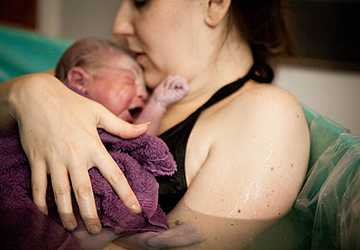Who Should Opt for a Home Birth
Embarking on the odyssey towards parenthood is punctuated with critical decisions, with the birthing location standing paramount among them. Electing for a domicile delivery entails a nuanced appraisal of variables unique to this path. This exposition aims to elucidate the pros and cons of home birth, identify who should consider home birth, and juxtapose home vs hospital birth, thereby arming prospective parents with indispensable insights for an informed deliberation.

Delineation of Home Birth Merits and Demerits
Merits:
● Tranquil and Intimate Environment: The sanctity and familiarity of one's dwelling proffer a serene sanctuary conducive to birthing, enhancing a sense of dominion and closeness.
● Tailored Maternal Care: The continuity of care from a dedicated midwife throughout the labour and delivery stages ensures a highly personalized and intimate caregiving experience.
● Liberty in Birthing Dynamics: The autonomy to navigate through various birthing positions and the extent of familial involvement is markedly amplified within the home setting.
● Diminished Frequency of Medical Interventions: Empirical evidence advocates for a noticeable decrement in the utilization of medical interventions such as cesarean deliveries and episiotomies in home birth scenarios.
Demerits:
● Emergency Contingency Constraints: The logistical gap in transitioning to a hospital milieu in emergent scenarios can precipitate risk factors.
● Pain Management Limitations: The spectrum of analgesia available at home is narrower, potentially complicating effective pain control during labour.
● Insurance Reimbursement Challenges: The absence of universal insurance coverage for home births can render it a financially burdensome choice.
Prototypical Candidates for Home Birth
The proclivity towards a home birth is a profoundly individualistic decision influenced by an amalgam of health, emotional, and logistical considerations. Conventionally, home birth may be deemed appropriate for:
- Low-Risk Pregnancies:
Home births are often deemed suitable for women experiencing low-risk pregnancies devoid of complications or pre-existing medical conditions, as they provide a milieu conducive to optimal maternal-fetal outcomes.
- Preference for Natural Birth:
Individuals inclined towards a more organic birthing experience, eschewing medical interventions in favour of physiological processes, may opt for home birth to imbue the event with a sense of authenticity and naturalness.
- Previous Positive Home Birth Experience:
Women who have undergone successful home births and feel at ease with the process may elect to do so again, buoyed by their past triumphs and the familiarity of the domestic setting.
- Desire for Personalized Care:
Those seeking individualized, bespoke care from a midwife or doula, characterized by attentive support and tailored interventions, may find home birth appealing as it affords them the undivided attention and nurturing, they crave.
- Comfort in Familiar Surroundings:
Some women experience heightened relaxation and a sense of agency when delivering in the comfort of their abode, enveloped by the ambience of their cherished surroundings, which fosters a profound connection to the birthing experience.
- Preference for Family Involvement:
Families desiring to include siblings or other relatives in the birthing process may opt for home birth to foster a more inclusive experience, wherein kinship bonds are strengthened, and familial support is a cornerstone of the birthing journey.

- Accessibility to Certified Midwives:
Access to seasoned certified midwives proficient in attending home births is a pivotal consideration for those contemplating this option, as their expertise ensures a safe and supportive environment conducive to optimal maternal and neonatal outcomes.
Comparative Analysis: Home Birth versus Hospital Birth
The analytical framework for home vs hospital birth necessitates a multifaceted assessment encompassing:
● Safety Infrastructure: Hospitals have comprehensive capabilities to address emergencies, providing surgical and advanced pain management options posthaste. Conversely, while home births are considered safe for uncomplicated pregnancies, they harbour potential risks should sudden complications arise.
● Environmental Disposition: The solace found in the familiarity of one's home may mitigate stress and cultivate a positive labour and delivery experience. On the other hand, the structured environment of a hospital may offer reassurance to those comforted by the proximity of medical resources and personnel.
● Autonomy and Environmental Control: Home births champion greater independence in the birthing process and the selection of participants, contrasting with the regulated and policy-driven ambience of hospital births, which may circumscribe personal preferences.
Sculpting a Tailored Birth Narrative: Delving into Home Birth Dynamics
Refining the Domestic Birthing Sphere
● Hallowed Environment Crafting: The art of transforming a section of your residence into a sacred space dedicated to childbirth enhances a sense of peace and harmony. Incorporating elements like custom adornments, melodic harmonies, and gentle illumination can create an oasis of calm.
● Emergency Protocols Design: The establishment of a robust emergency strategy is imperative. This encompasses a direct communication conduit to medical practitioners and a meticulously planned pathway to the closest medical facility.
Synergy with Medical Allies
● Engagement with an Accredited Midwife or Doula: The alliance with a medical guardian who shares your vision for birth and reveres the sanctity of the home birthing process is crucial. Their understanding of facilitating births outside the clinical setting is indispensable.
● Birth Scheme Formulation: Crafting a comprehensive birth strategy with your medical partner guarantees that your birthing preferences are explicitly understood and honoured.
Deciphering Legal and Operational Frameworks
● Legal Landscape Navigation: Acquainting oneself with the statutes and ordinances governing home births in your region ensures adherence to legal standards and a clear comprehension of the professional boundaries of midwives or doulas.
● Insurance Exploration: A thorough examination of your insurance policy to determine the extent of home birth and associated healthcare coverage is pivotal for strategic financial planning.
Postnatal Recuperation at Home
● Support Network Establishment: The assembly of a robust support cadre comprising kin, comrades, or a postnatal doula is beneficial for aiding the recuperative phase, offering assistance with domestic responsibilities and infant care.
● Professional Postnatal Support Access: Securing professional postnatal assistance for both mother and infant, including breastfeeding advice and health evaluations, is vital for a seamless transition to parenthood.
Conclusion
The intricate deliberation between home vs hospital birth is predicated upon an exhaustive contemplation of the pros and cons of home birth and a discerning comprehension of who should consider home birth. Conversations with healthcare practitioners, introspection on personal health narratives, and contemplation on birthing preferences are pivotal in navigating this choice. Central to this discourse is the unequivocal imperative of prioritizing the health and fortune of mother and child.










